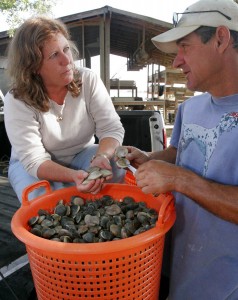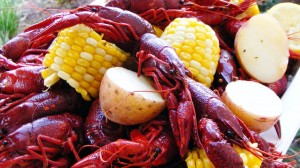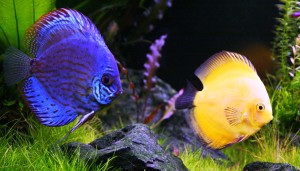Cheese grits, hush-puppies, and catfish; sweet corn, potatoes, and crawfish; dirty rice, coleslaw, and shrimp! What do all of these delicious foods have in common? The answer is AGRICULTURE – including the catfish, crawfish, and shrimp! Aquaculture (or aquafarming) is agriculture. In fact, the Florida Aquaculture Policy Act (Chapter 597, Florida Statutes), establishes that aquaculture is agriculture, and the Florida Department of Agriculture and Consumer Services (FDACS) is the lead aquaculture agency.
Florida’s aquafarmers grow products for food (fish and shellfish), aquarium hobbyists (tropical and marine fish, aquatic plants, corals), leather goods (alligators), fishing (bait), biological control (grass carp), or for “seed” for national and international aquaculturists. Additionally, and according to the FDACS, Division of Aquaculture, Florida Aquaculture Report, Issue No. 69 March 2009, “Aquaculture across the United States ranked 12th amongst all agricultural sectors with 6,409 farms reporting farm-gate income of $1.4 billion. Florida aquaculture ranked 7th amongst all states with 469 farms reporting farm income of $61.3 million. Aquatic plant production is not included in these statistics. Ornamental fish (freshwater and marine tropicals, koi, and goldfish) continue to be the largest segment of Florida aquaculture with 203 farms reporting farm-gate income of $32.1 million.
“Florida is the leading producer of ornamental fish in the United States followed by California at $13.4 million. Mollusc production (hard clam) is the next largest segment with 130 farms reporting $15.2 million in sales. Florida ranked fourth in the nation behind Washington ($85.2 million), Louisiana ($37.3 million), and Virginia ($36.9 million). Other aquaculture products (alligator, turtle, triploid grass carp, live rock, snails, frogs) produced by 43 farms yielded $6.2 million. Other food fish production (hybrid striped bass, tilapia, sturgeon) from 37 farms reported $3.4 million in sales. Crustacean production (shrimp, crawfish, prawn) from 17 farms reported $2.5 million in sales. Catfish production by 54 farms sold $979,000. Sport and game fish (largemouth bass, sunfish) production from 31 farms totaled $622,000. Five bait farms reported $71,000 in sales.” These data are available from The USDA 2007 Census of Agriculture report.

Leslie Sturmer, left, an aquaculture extension agent with UF/IFAS, checks clams with Mike Hodges of Hodges Seafood Company in Cedar Key. Mike has worked closely with Sturmer to build the clam industry in the Gulf Coast village. (AP Photo/University of Florida/IFAS/Thomas Wright).
Just like agriculture, aquaculture requires knowledge, skills, and abilities in animal husbandry, pest and disease management, environmental best management practices, plant and animal nutrition, biology, water quality, marketing, economics, and mechanics. The challenges aqua-farmers face are similar to those faced by agri-farmers: increasing production costs, fluctuating market prices, new pests and diseases, unpredictable weather, etc. To assist aquafarmers develop efficient production, the Florida Aquaculture Policy Act specifically directs FDACS to support and plan for aquaculture industry growth in Florida. As with any type of farming endeavor, integration of all available management tools, keeping up with the latest research and developments, and collaborating with stakeholders will help create a successful enterprise.
For more information or to assist you in your Aquafarming operations, please visit the following University of Florida and FDACS resources.
UF/IFAS:
Freshwater Aquaculture & Farm Ponds
- Aquatic Crops
- Business Management
- Fisheries
- Getting Started
- Harvesting & Grading
- Health
- Nutrition
- Production Practices & Pond Management
FDACS:
- Maintaining Dissolved Oxygen Levels in Your Pond to Reduce Fish Kills - September 21, 2018
- The Bumble Bee – One of Florida’s Vital Pollinators - September 14, 2018
- 2017-2018 Bee Informed Partnership’s National Bee Colony Loss Report - July 13, 2018


